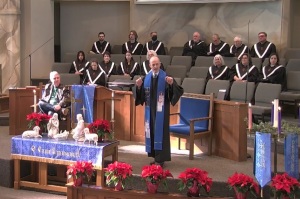Organizing a Group Bike Trip on The C&O Canal
CUMBERLAND, Md. (AP) - Can we all just get along?
That question ran quietly through my mind as I prepared to lead a dozen workmates on a four-day bicycle ride along the C&O Canal from Cumberland in western Maryland to Washington.
Prickly personalities weren't the concern. The big gap in biking experience was.
A few of us were veterans of weeks-long or even months-long expeditions in the saddle. Several others had barely been on a bike for years. Our bikes ranged from fancy wheels right out of the shop to tough old machines.
And we had 184.5 miles to cover — together.
Not a problem. There's something about the C&O that makes these differences not matter.
Bicycling the canal, on a dirt towpath where mules once hauled barges, is like riding through a watercolor painting of nature all day long. Spring, summer and deep into fall, it's like inhaling a passage from "Walden" and exhaling a verse from Robert Frost.
After splashing through the first dozen mud puddles, seeing the first of the turtles lazing on fallen trees in still water, and getting swallowed by the luscious greenery — as if we'd leaped into that painting — I knew we'd found our stride.
The C&O, it turns out, is an ideal proving ground for casual cyclists looking to push their limits. It's long, flat and traffic-free, plus gorgeous.
Those same qualities engage dedicated cyclists, too, who can stretch the daily mileage if they want and speed a little faster through the same grand tapestry.
And what a tapestry. On one side is the broad, rushing Potomac River; on the other, the placid canal. Above, a canopy of leaves.
Along the way: 74 locks with massive wooden gates patterned on the designs of Leonardo da Vinci, 11 aqueducts and dozens of white brick houses where gatekeepers tended locks and gardens until the canal went bust in 1924.
The human imprint is frozen in time here. Nature is in motion.
Now herons, songbirds, snakes and the ubiquitous turtles make their living on the C&O.
It wasn't supposed to be this way when people started carving the earth in 1828 to make a waterway for coal and commerce from the Allegheny Mountains to the East Coast.
They reckoned a canal stretching between Chesapeake Bay and the Ohio River would beat the railroad in the race west. The railroad won — and so did the great outdoors.
Today, the C&O joins the recently expanded Great Allegheny Passage rail trail to give cyclists a 320-mile offroad route along sparkling rivers between Washington and the outskirts of Pittsburgh.
In an eclectic bike group — probably any bike group — the key to smooth riding is for people to go at their own pace with no expectation to ride as a pack.
Put an experienced cyclist at the rear to ensure no one is left behind. Work out a lunch stop and each day's destination in advance. Let everything else come naturally.
This is easy on the C&O because, except on a road detour or two, you can't get lost.
We often found ourselves three or more miles apart front to back as the days stretched out. We'd pair up to chat for a spell, drop back to take pictures, race ahead to visit a companion.
We'd ride for tranquil periods with no one else from the group in sight — alone but never really alone.
The trail has no hills — just eight-foot dips at each lock. It drops a negligible 600 feet over its full length west to east. That makes for fine riding in either direction but a slight advantage starting from Cumberland.
Expert riders can do it all in two days but won't be stopping to smell the wildflowers. Three days on dirt is a good workout even for seasoned cyclists.
Four days is the sweet spot for anyone wanting to linger in nature and history while covering 40 to 70 miles a day.
The trip can also be done in three days (first leg, 61 miles from Cumberland to Hancock; second leg, 63 miles to Harpers Ferry, W.Va.; third leg, 61 miles to Washington). Our group did it in four days, stopping in Little Orleans, Williamsport and Point of Rocks, with vehicles waiting to take us to lodging several miles off the trail. Here are the details.
DAY 1: CUMBERLAND TO LITTLE ORLEANS, MD., 44 miles:
Within minutes of rolling out of picturesque Cumberland, the C&O began casting its pastoral spell.
The ride began after a night of thunderstorms and morning showers that turned the trail into a succession of mud puddles. We plowed through them. Mud is fun.
Late in the day's ride, we came to one of the engineering marvels of the trip, the astonishing Paw Paw tunnel. Running through a mountain for three-quarters of a mile, the brick-lined tunnel is so dark you can't see the path without a light. Walk the bike.
We finished for the day at Little Orleans, which has nothing but a little bar-restaurant and a campground, where one of us stayed. The rest shuttled six miles to the mountaintop Town Hill bed and breakfast, http://www.townhillbnb.com/, the only lodging around.
Tips: This section is remote; pack plenty of fluids and lunch. In case of recent storms, check trail conditions, washouts and detours; http://www.nps.gov/choh/planyourvisit/closures.htm or 301-739-4200. Cell phone coverage is poor; text messages go through better than calls.
DAY 2: LITTLE ORLEANS TO WILLIAMSPORT, MD., 41 miles:
The trail closely hugs the meandering Potomac here, bringing even more sparkle to the ride, wider views and cooling breezes.
At Lock 56, we can stay on the C&O or take the parallel and paved Western Maryland Rail Trail for 21 miles. Most of us opt for the pavement. We stop in Hancock for lunch, bike past imposing Fort Frederick from the French and Indian War and end our shortest day's ride at Williamsport, where there is lodging.
Tips: The paved rail trail is a pleasant change of pace. A road connecting back to the C&O from the rail trail is hilly and requires attention to traffic.
DAY 3: WILLIAMSPORT TO POINT OF ROCKS OR WHITE'S FERRY, MD., 52-70 miles:
In this section the river turns urgent. We bike alongside swirling froth, rapids and craggy rocks to our right, cliffs to our left. Parts of the canal are dried up here.
We leave the C&O for a huffing and puffing climb up a hill and across the river into funky Shepherdstown, W.Va., for lunch.
The miles ahead are steeped in agonizing history, for this is land soaked with the blood of the Civil War. To the left, off the trail, is Antietam, site of the worst one-day carnage in U.S. military history. Farther down the trail is Harpers Ferry, where abolitionist John Brown incited a slave insurrection.
Some of us stop at Point of Rocks and shuttle to Leesburg, Va., for the night. The rest ride 18 more miles to White's Ferry and cross the Potomac on its only remaining cable ferry, rejoining the others in Leesburg.
Tips: A long-term closure at milepost 88.1 means cyclists must detour on paved country roads for a few scenic but hilly miles. Don't ignore the detour sign. Ahead it's washed out, buried under a rock pile and laced with poison ivy. Antietam is a beautiful and haunting side trip. Harpers Ferry is also worth seeing but requires hauling bikes up a steep staircase and hill. Some Leesburg motels and B&Bs will pick cyclists up at the Virginia side of White's Ferry, about five miles from town.
DAY 4: POINT OF ROCKS TO WASHINGTON, 48 miles:
The final stretch is surprisingly remote. Load up on lunch in White's Ferry for the miles ahead. Not until spectacular Great Falls, 14 miles from Washington, are there more trailside services.
By now, we've had a few flat tires to fix and a couple of spills among us. One of us will finish with a compressed-nerve numbness in one hand that will take more than a month to go away, a common malady that calls for good padded gloves and varied hand position on the bars.
But everyone who set out for the whole 184.5 miles finishes, and that's what counts.
Those who worried about waking up sore and tired after one big day found themselves eager to tackle another day, and another.
The canal ends in Georgetown, where the mules of another century rested from their great labors before turning around and doing it all over again.
It was rush hour in the capital. Out of the watercolor painting we went.




























